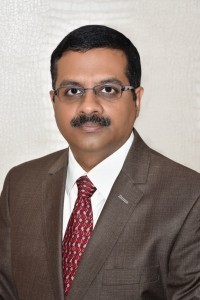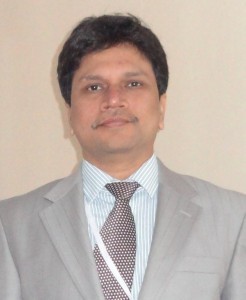
Co-Founder & Director
What makes Telematics4U unique from the numerous other IoT firms?
We are a fourth sector organisation in delivering ‘technology as a service’ for the real world or the outer world of an enterprise using Internet of Things. Traditional organisations such as the government, non-profits and businesses have seen their boundaries getting blurred as they mix social responsibility and environment in addition to their business vision. With the Internet of Things, technology updates such as automating a fleet has the benefit of not only making the systems more efficient and transparent, but also does its bit to make life easier for people who depend on that sector.
How did these traditional firms manage themselves before IoT?

It used to be very liner. Now a days it requires a comprehensive approach and a non-linear approach for a sustained growth. To give you an idea of how it was running traditionally, a logistics company in Karnataka who runs a huge fleet had appointed and paid people in dhabas to call and alert them whenever their vehicle passes through a certain area. Thus, the central office was able to keep track of where their vehicles were at that moment and which direction they were moving towards.
How did it first evolve from manual to automated?
The next update to this process was where the drivers were asked to make calls every 150kms to the main office so that they know which STD booth the call came from. Things moved further to pagers, and then to mobile phones. This is where they first began getting location information from a device. Using modern technology and platform, it is possible to take this data and get information out of it. In the case of our previous example, this would mean that the location is the data point. Then we can use that information to gain intelligence, and use that intelligence to deliver decision support and analytics.
Could you give an example of how you have taken this technology to the extra mile for a real-world customer?
There is a people mobility company for the business of self drive cars – not self driving cars driven by artificial intelligence but people who are able to pickup cars from their surrounding using just their smartphones. We have built an important technology piece called a ‘Wise Fog Platform’ for them, where we are able to control the car, monitor driving behaviour, support in ‘Emergencies’ and also created a platform for recovery. Very unique features such as opening and closing the door, through a mobile phone using a Bluetooth connection; connect many sensors of the car and make local decisions using Fog Network is a very unique solution. The operational platform is very user friendly and can be viewed over web as well as mobile application platforms. The customer can also get many business operational analytics on the fly.
What wireless technology did you go for here, and why?
Specifically for Self-drive business Solution, we opted for Bluetooth Technologies as a primary communication, with a fall back on general packet radio services (GPRS) and SMS communication.. Their business relies on parking cars in different locations and delivering cars to customers within a certain time. The moment the car is started, the control system knows that it has to start billing the customer. It looks at the distance and the location data to transfer data and readings. Once the customer’s trip is done and he leaves the car, the control system does a check if the glass is rolled up, batteries intact, bonnet and boot closed, etc., If all is well, then the car door is locked and the trip gets closed. The backend system has already the information of customer’s credit card and the same will be used to complete the billing / payment process.
Could you talk about a customer challenge that your team was able to solve?
One of the challenges that our customer faced was the theft of removable items inside the car, as well as vehicles with door, window, boot or other things left open. We created a sensor fog network inside the car where there are sensors attached to the battery, the doors, windows and other removable objects. Once we interconnected all of these IOT pieces together, it is now virtually closed until the authorised person comes close to the car. The ignition key is left inside the car, so that authorisation to access the vehicle can be quickly passed from one person to another digitally. Another important safety feature is that if the vehicle is stolen or faces unauthorised use, we have an option to remotely immobilise the car and receive an alert. We have also put in features like alcohol detection and other proactive safety features.
What is your view on the V2X space?
We believe it will be huge. We are already thinking of the V2X space and are watching and following the standards development by companies like NXP, Cisco, Intel and others. It is in our roadmap. What has happened is that it has evolved from M2M to V2V (vehicle-to-vehicle). Then it got into V2I (vehicle-to-infra), and now it has gotten to V2X (vehicle-to-anything).
Any other spaces where you have started building custom solutions for?
We are also looking at things like livestock, where we can monitor cows. This technology answers questions like how their health metrics are looking like, where are they moving, whether vaccinations and other procedures have been completed, and more. We do this by using radio-frequency identification (RFID) chips that are embedded into them, which then start giving us data to show their wellbeing. All the required information is then shown to the people managing the livestock on a platform.
What is another area where you believe IoT could be quite the disruptor?
Fixed things like hoardings too have their own IoT solution being designed and implemented. We are installing a lot of beacons and mobile smartphones applications. Now if you consider a real scenario like when we land in Bangalore airport after a trip, I am busy catching up with notifications on my phone as it just got its Internet connection back. It happens to almost everyone today. So a lot of money has been put to place the hoarding, but no one sees it. So the question is how do I make that billboard come to my phone – because I am always glued to my phone. We are also putting technologies on the hoarding itself to monitor the hoarding quality – this includes whether the flex has torn, lights are on or off or missing, and many other quality metrics. Any firm investing in marketing will want to know how their marketing activity has resulted in actions or responses from their potential customers.
Any interesting technology within the automotive space that has got your R&D team excited?
There is a standard called on-board diagnostics (OBD) for vehicles, on which we are already working. We intend to use the OBD device with GPRS, so that we are able to access the data from anywhere. Another is to interface the OBD device with Bluetooth to a smartphone so that the user can use a smartphone to view real time data. One of the things we do for many of the distribution companies is we use a backend platform to calculate routes using a mix of pickup points, location information, traffic information and average speed of different routes. We have a routing engine, which you can populate and put some parameters into, and the engine runs an algorithm and throws out the possible three routes.
What do you believe to be one of the strongest strategies for an IoT firm?
One of our main strategies is that we are hardware agnostic and vendor independent. We always work with multiple vendors and do not depend on one vendor. We also have regular interactions with vendors, as well as via Internet research, which helps us to discover or keep up with new technology trends. Most important thing in IOT deployment is the last mile. This is something we have a huge network of entrepreneurs who are completely capable of executing the last mile and be mutually successful.
What are your favourite technologies?
Creating a fog network using hundreds of sensors in a small area is something that interests us very much. The second favourite technology is the Beacon, which is also something that we use a lot. Beacon technology is something that is so flexible that we can use it in various applications. In the fog network, Bluetooth is one link that we are using to connect with multiple sensors. So we are not using multiple newer IOT radios technologies like LoRa and create Fog network for local decision making.
Any existing technology that your R&D team feels is not enough?
We are a solution provider and perhaps one area where we feel there are standards but yet to evolve in Indian context is OBD2 interface or CAN Interface. This talks to vehicle ECU directly and get intelligence. It has many features like giving us the data for getting fuel information, engine RPM, odometer data and others So while is a cool piece of interface technology, but may not always work for the customer. That is why we are working on building a vehicle independent technology. The ‘Wise Fog Platform’ is a good solution for those cases where our customer has multiple cars from different manufacturers, yet they would be able to achieve their business objectives using our solution approach.














